Best drones in 2024
Here are the best drones based on design, ease of use, camera quality, durability and flight time.

It's easier than ever to take to the sky with one of the best drones. Today's quadcopters are a cinch to pilot, and can take some impressive photos and videos. What's more, there's a drone out there to suit just about every need and price, whether you're a videographer, vlogger, or just want to have some fun.
The best drones have also dropped in price; you can now find great models starting at less than $300 — though if you want to spend more than $1,000 on top-notch video and flight performance, we've tested them too. (If you're looking for something for your kid, we recommend checking out our picks for the best cheap drones.)
When buying a drone, there are a lot of things to consider, including flight time, what you want to do with the drone, and more. That's where our guide comes in. We've flown all the top models, evaluating their handling, controllers, endurance, camera quality, and more. Below are our top picks for drone pilots of every stripe.
The best drones you can buy today
Why you can trust Tom's Guide

Specifications
Reasons to buy
Reasons to avoid
For most people, the DJI Mini 2 will be the best drone for their needs. It's tiny—able to fit in the palm of your hand—easy to fly, and can last up to 31 minutes in the air. And, at $449, it's also the least expensive of DJI's drones, making it more accessible to the masses.
The Mini 2's camera resolution has been improved over the previous generation, so it can now shoot at 4K/30 fps. And, because it's gimbal-stabilized, it's just as smooth as ever. Because of its light weight—249 grams—you don't need to register the Mini 2with the FAA, but it also means that the drone is more susceptible to high winds. Still, it's amazing what DJI packed into the miniscule Mini 2.
Read our full DJI Mini 2 review.
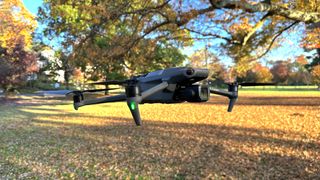
Specifications
Reasons to buy
Reasons to avoid
If you took the DJI Mavic 3 and sliced off the 28X digital zoom — and $500 — you'd get the DJI Mavic 3 Classic. Otherwise, everything we loved about the Mavic 3 is here in the Mavic 3 Classic — amazing camera quality, incredibly long flight time, and excellent obstacle avoidance.
In fact, we like the Mavic 3 Classic so much that we think it's the better option for most videographers — unless you really need ProRes video. The 28X zoom on the Mavic 3 is a neat trick, but it's ultimately not all that useful. So, save yourself half a grand and thank us later.
Read our full DJI Mavic 3 Classic review.

Specifications
Reasons to buy
Reasons to avoid
The DJI Mini 3 is a good middle ground between the $760 DJI Mini 3 Pro and the $449 Mini 2. Like the Mini 3 Pro, the Mini 3's camera can rotate 90 degrees, so that you can take vertical video — great for capturing tall buildings in their entirety, or yourself, if you're the selfie-type.
What we like even more about the Mini 3 is that it has pretty epic flight time — up to 51 minutes with the extended battery. You'll probably run out of room on your memory card before the Mini 3 needs to return home. However, to cut costs, the Mini 3 doesn't have as many obstacle avoidance sensors as the Mini 3 Pro, and its camera is a little less capable — there's no slo-mo video setting, for instance. But those are fine tradeoffs to get you a drone for less than $500.
Read our full DJI Mini 3 review.

Specifications
Reasons to buy
Reasons to avoid
The DJI Mavic 3 is the best drone for prosumers and videographers who want the best camera drone without having to purchase a camera and drone separately. Outfitted with a micro 4/3 Hasselblad sensor and a 1/2 inch CMOS camera, the Mavic 3 can record video at resolutions of up to 5.1K/50 fps, and it has a 28x digital zoom that's also pretty impressive.
We also love that the Mavic 3 can fly for up to 41 minutes — a near-eternity for drones. It also has excellent object-tracking and 360-degree obstacle avoidance, so you can really record what you want without worrying about crashing into things. All of this comes at a cost: The Mavic 3 starts at $2,199, which is significantly more than the Mavic 2 Pro, which it replaces.
However, DJI has also released the DJI Mavic 3 Classic, which costs $500 less. This model lacks the 28x digital zoom of the Mavic 3, the optional SSD and ProRes video support, but is otherwise the same.
Read our full DJI Mavic 3 review.

Specifications
Reasons to buy
Reasons to avoid
A step up from the DJI Mini 2 and Mini 3 is the DJI Mini 4 Pro, which is the same size and weight, but has a more advanced camera. Cleverly, the DJI Mini 4 Pro's camera can rotate 90 degrees, to make it easier to shoot vertical video and photos — great if you want to capture the entirety of a skyscraper, or want something easier to share on social media. It's also excellent at tracking moving subjects, and, thanks to added object detection sensors, can avoid trees and other things as it follows you around.
What makes the latest in the series outstanding is its improved low light performance, producing usable footage without the noise and grain other drones deliver. Even better, we love how it has the best video transmission feed in any drone to date with its 1080p 60fps transmission — making the controls feel more responsive than ever before.
Read our full DJI Mini 4 Pro review.
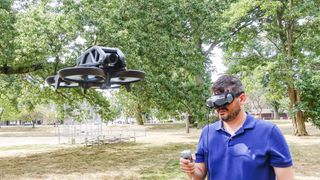
Specifications
Reasons to buy
Reasons to avoid
For those who want a real taste of drone racing, the DJI Avata is a good place to start. Like the larger and older DJI FPV, the Avata comes with a pair of FPV goggles, so that you get a first-person view of where your drone is flying, delivered straight to your eyeballs. It also comes with a clever handheld controller that makes flying the Avata more like piloting an aircraft.
The Avata was a lot of fun to fly, and easy to pick up. Its fixed propeller guards also make it better able to withstand the errant crash into the ground, a tree, or whatever else is in its flight path. We didn't feel as queasy using the new goggles that came with the Avata as we did with DJI's older FPV goggles, but these were slightly less comfortable. Still, you won't be wearing them for too long a time, as the Avata's battery life of 18 minutes is much shorter than photography-focused drones.
Read our full DJI Avata review.
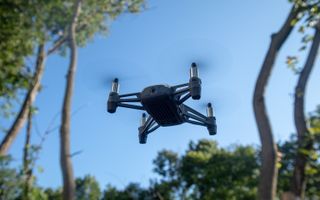
Specifications
Reasons to buy
Reasons to avoid
For just under $100, the Ryze Tech Tello—designed by DJI—makes for a good, inexpensive drone for first-time fliers. However, what elevates it above other inexpensive drones for kids is the fact that it can be programmed using Scratch, turning this toy into an educational device.
In addition, the Tello has a 720 camera that records pretty good video, and is easy to fly around. The biggest issue we had with the drone was its short 5-minute flight time, so you'll want to stock up on a few batteries if you decide to pick it up.
Read our full Ryze Tech Tello review.
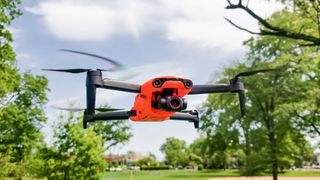
Specifications
Reasons to buy
Reasons to avoid
While it seems like DJI makes all the best drones, Autel has a number of models, including the Evo Nano+, that offer a really compelling alternative. We found the Evo Nano+ just as maneuverable and easy to fly as any DJI drone, and the Nano+'s small size and light weight means you can take it almost anywhere. We especially like that the drone comes in more than one color, unlike DJI's drab gray.
Video and photos taken with the Evo Nano+ were sharp, crisp, and colorful, and the camera's 3-axis gimbal kept everything steady and smooth. However, the Nano+ has a slightly shorter flight time, and is a bit more expensive than DJI drones with similar capabilities, such as the Mini 3 Pro. But, if you're looking for something different, check out Autel.
Read our full Autel Evo Nano+ review.
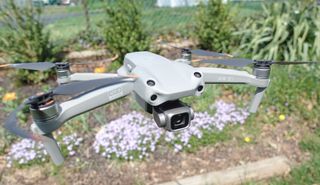
Specifications
Reasons to buy
Reasons to avoid
Sitting between the DJI Air 2 and the DJI Mavic 2 Pro is the DJI Air 2S, which combines some features of both in a drone that costs about a grand. The DJI Air 2S has a 1-inch image sensor — twice that of the DJI Air 2 — which means you'll get some stunning photos. It also has a new feature called MasterShots, in which the drone will analyze what it's looking at, and then automatically generate a flight pattern and create a movie, complete with a soundtrack.
Like all other DJI drones, the Air 2S was a pleasure to fly. It's incredibly easy to pilot and hovers like a statue. It has the same transmission technology as the DJI FPV, so it can fly further than most other DJI drones. Its 31-minute flight time is a few minutes less than the DJI Air 2, but we suspect some will gladly make the tradeoff for better videos.
Read our full DJI Air 2S review
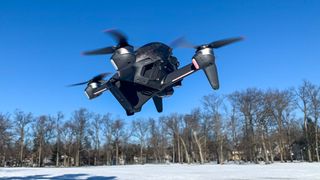
Specifications
Reasons to buy
Reasons to avoid
For those who want to get a taste of drone racing — or simply want to see the world as a bird would — the DJI FPV will get you there. This drone comes with a pair of FPV goggles that give you an incredibly immersive view of what the drone is seeing, with no noticeable lag or delay.
The DJI FPV has three mode settings, so novices can increase its capabilities as their abilities grow. In full manual mode, the FPV can reach speeds of up to 87 miles per hour — just watch out for trees! It's incredibly maneuverable, zipping up, down, left and right like a hummingbird. Get an extra battery, though, because the FPV's only lasts 20 minutes, and you'll want to spend a lot more time in the air.
Read our full DJI FPV review
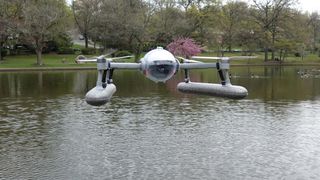
Specifications
Reasons to buy
Reasons to avoid
The Powervision Poweregg X can go where most other drones can't: In the water. That's because the Poweregg X has a removable waterproof shell and pontoons that allow you to land and take off from ponds, lakes—even the ocean, if it's calm enough. And, the drone's body can even be used as a camcorder, making it useful even when it's not in the air.
We found that the Poweregg X flew well, if a bit slowly (the pontoons do weigh it down), can fly up to 25 minutes or so on a charge, and has pretty good object tracking. However, video and photo quality, while above average, did not measure up to DJI's drones. Then again, try landing one of DJI's drones in the water and see what happens.
Read our full Powervision Poweregg X review.
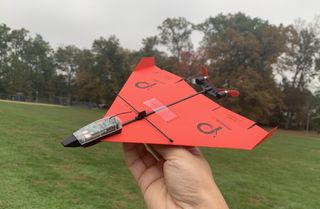
Specifications
Reasons to buy
Reasons to avoid
The PowerUp 4.0 takes the traditional paper airplane and brings it to the next level. This little kit attaches to an ordinary airplane, and thanks to a pair of propellers, lets you pilot the plane from your smartphone. The kit comes with four pieces of paper with an airplane pattern, but you can also download patterns for free from the company's website.
As we found, there's a bit of a learning curve when it comes to keeping the PowerUp 4.0 in the air. You'll need a lot of space to fly the plane; we recommend a football field. But once you get the hang of it, you'll be surprised at how far it will go.
Read our full PowerUp 4.0 review.
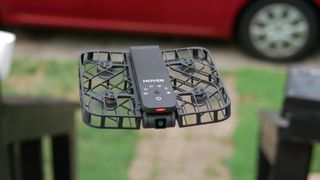
13. HoverAir X1
Specifications
Reasons to buy
Reasons to avoid
Looking for a versatile drone that's super lightweight and can be controlled without any prior piloting experience? The HoverAir X1 is the best drone for the job, offering a great selection of features for the flier who wants more without having a lot of flying experience. What makes the HoverAir X1 unique is that it's incredibly compact, so much so that it can fit in a pocket.
Meanwhile, it flies all on its own with preset flying modes to choose from. We've also put its subject tracking feature to the test, and it manages to keep subjects in frame even when there's some obstacles. For its size, we're impressed by its video performance and long battery life.
Read our full HoverAir X1 hands-on.
How to choose the best drone for you
Drones aren't just fun to fly. They can let you capture breathtaking footage, some in high-resolution 4K video. They're also more affordable than ever, as quality beginner models now cost less than $60. Good camera drones start at a few hundred dollars, and they're great for simple tasks like checking your gutters for leaves. More complex drones, starting at less than $1,000, offer customizable and programmable features, turning them into truly autonomous devices that can make their own decisions.
Drones aren't that complicated, but there are a few key features you should consider when you are shopping. There are also some key rules you need to follow when you take to the air.
Legal Requirements
FAA has rules you have to follow. The most important two: Never fly around or above people, and always keep your drone in sight. The FAA has a full list of safety guidelines for model aircraft that you should check before you take off. There are also restrictions on where you can fly: For example, within 5 miles of an airport is off limits. Mapbox provides a great interactive map of no-fly areas, and local RC (Remote Control) aircraft clubs may list fields that they use.
Non-commercial drones that weigh between 0.55 pounds and 55 pounds have to be registered (there's a $5 fee), and have to carry your license with you while flying the drone.
MORE: How to Register Your Drone with the FAA
Remote Control
Most drones use a remote control with two joysticks — a bit like one of the best PC game controllers. One stick controls what's called the attitude of the quadcopter, including roll (tilting left and right) and pitch (tilting up and down). The other stick controls throttle and the rotation of the quadcopter. A good remote control should fit well in the hand, with sticks resting comfortably under your thumbs and providing a smooth, responsive feel that allows you to guide the quadcopter by touch.
Some less expensive models skip the remote control, or offer it as an extra-cost feature, and instead use a smartphone connected via Wi-Fi and a flying app. These apps often provide a live video view from the quadcopter camera. However, apps don’t allow the precision of real controllers: It is easier for your thumbs to slip, possibly causing a crash.
Repairability
Despite what the ads tell you, drones crash all the time. A good drone will take an unplanned descent and ground interface (aka: a crash) in stride, without damaging the frame. It will also include shields to protect the rotors and electronics from harm.
Regardless, things still get broken sometimes, particularly racing drones. A good model will offer a ready supply of cheap parts like rotors and struts to replace the broken ones, and will make it easy to swap these parts out when required. The same is true of batteries.
Battery life
Most drones will last between 20 to 30 minutes on a charge, and are designed so that you can quickly swap out batteries. To ensure that you can keep filming, it's a good idea to purchase extra batteries. Just make sure to charge them beforehand!
Camera quality
Want to show off your aerial exploits? A camera, either built-in or add-on, can capture those dramatic vistas for posterity. The best drones will have cameras that can record video at resolutions of 4K or higher, but even budget models are getting better, able to capture video at 1080p. However, they tend to use smaller image sensors, so the quality won't be as good.
While not covered in this guide, there are professional drones which let you attach mirrorless or DSLR cameras, which provide even greater image quality that built-in cameras. However, these drones typically cost upwards of $2,000.
The best camera drones will also mount their cameras on a gimbal, so that your image stays steady as the drone is flying around. If video is your priority, look for a drone that has a three-axis gimbal; that will give you the most stable image.
Some drones also offer first-person view (FPV), sending a pilot's-eye view from the drone itself to a phone or tablet. Some models offer video goggles for the ultimate pilot-seat flying experience.
Features
Drones are getting smarter; now, instead of just flying around based on manual inputs, you can program drones to fly pre-programmed routes, or even follow specific objects, such as people and vehicles. Depending on your needs, it's worth examining what features a drone has before buying one.
How we test the best drones
When we take a new drone out for a spin, we evaluate it based on a number of factors:
- Design: How well is the drone built, and does it look good? If it comes with a controller, we take a look at its ergonomics.
- Durability/Repairability: Face it. You're going to crash your drone at least once, but a good model should be able to survive a few mishaps without a problem. And, if something happens to break (it's usually a rotor), how easy is it to repair?
- Flight Performance: How easy is the drone to fly? Is is stable when hovering, or does it require a lot of stick work? How does it respond to your commands?
- App: How intuitive is the app? What sort of features are available?
- Camera Quality: If the drone has a camera, then how good are the photos and videos it takes?
- Flight time: How long can the drone stay in the air before its battery runs out? This varies a lot based on the size of the drone, but the best drones have batteries that last up to 25-30 minutes.
- Price: Obviously, we don't expect a $50 drone to perform as well as a $1,000 drone, so we take its cost into consideration when rendering a final verdict.
Drone FAQ
Can drones fly for hours?
It all depends on the type of drone you buy. Drones that look like airplanes, which can use the air to stay aloft, can remain airborne for a long time. However, drones that look more like helicopters — most drones have four rotors — can only stay up for about half an hour at best. However, flight time is slowly improving, and the best drones can stay in the air for around 40 minutes.
What are the different types of drones?
Drones generally fall into a few categories:
Mini or micro drones, which can fit in the palm of your hand, make great starter drones. Because of their size, they'll usually only have a couple minutes of flight time.
Racing drones, which are slightly larger, and are incredibly light, fast and nimble. Most racing drones are hand-built and easily repairable, as they tend to crash into things often. They're almost always used in conjunction with a pair of FPV goggles. Like mini drones, their flight time is often less than 10 minutes.
Camera drones are purpose-built to take video and photos. They will have a gimbal-mounted camera and software that allows them to track people or objects, or fly predetermined routes. These drones will generally have the longest flight times.
Toy drones can include mini drones, but generally cost less than $100. Many will have cameras, but video quality will be far worse than what you'll find with a camera drone. Their flight time will average around 10 minutes, and will have few autonomous features. However, they're great for learning the basics.
More from Tom's Guide
Sign up to get the BEST of Tom’s Guide direct to your inbox.
Upgrade your life with a daily dose of the biggest tech news, lifestyle hacks and our curated analysis. Be the first to know about cutting-edge gadgets and the hottest deals.

Michael A. Prospero is the U.S. Editor-in-Chief for Tom’s Guide. He oversees all evergreen content and oversees the Homes, Smart Home, and Fitness/Wearables categories for the site. In his spare time, he also tests out the latest drones, electric scooters, and smart home gadgets, such as video doorbells. Before his tenure at Tom's Guide, he was the Reviews Editor for Laptop Magazine, a reporter at Fast Company, the Times of Trenton, and, many eons back, an intern at George magazine. He received his undergraduate degree from Boston College, where he worked on the campus newspaper The Heights, and then attended the Columbia University school of Journalism. When he’s not testing out the latest running watch, electric scooter, or skiing or training for a marathon, he’s probably using the latest sous vide machine, smoker, or pizza oven, to the delight — or chagrin — of his family.
